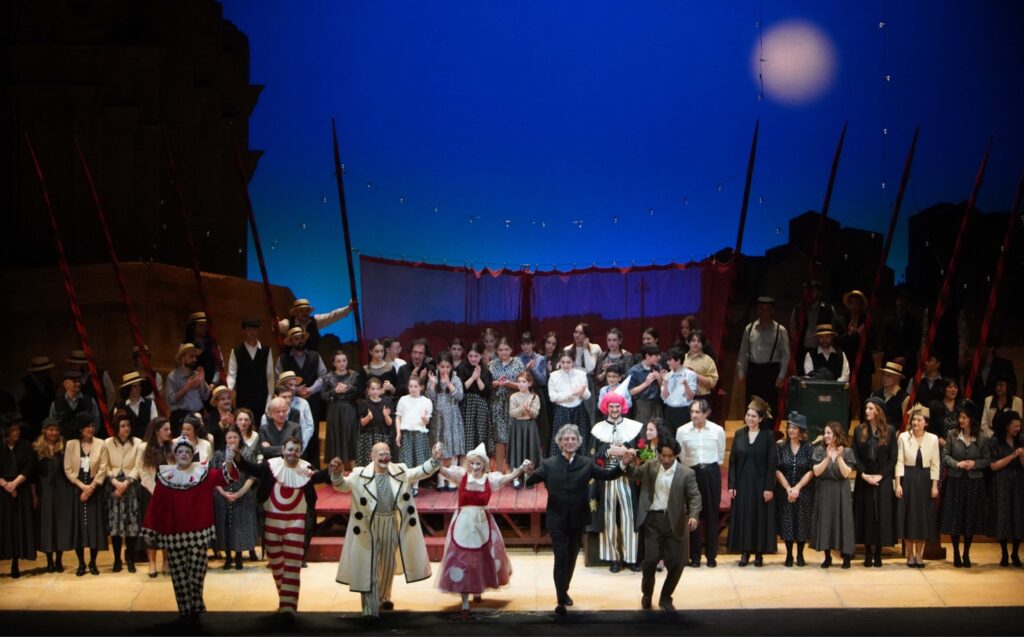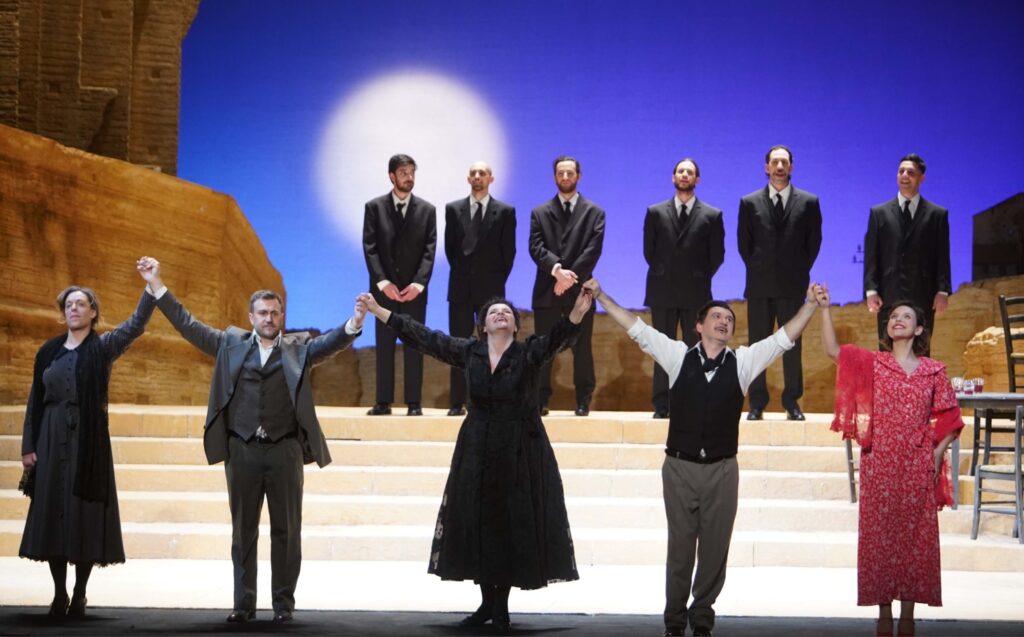Teatro Municipale di Piacenza 2025
By Bernardo Gaitan
As the 19th century came to a close, during a period of artistic transition, young composers sought to innovate and redefine the operatic language. It was in this context that, almost fortuitously, the most emblematic diptych of Italian musical theater and the ultimate prototype of verismo opera emerged: Pietro Mascagni’s “Cavalleria Rusticana” and Ruggero Leoncavallo’s “Pagliacci.” Today, considered masterpieces, these operas once signaled the dawn of a new era for Italian opera.
When “Cavalleria Rusticana” won the Sonzogno competition for one-act operas, Mascagni was still an unknown figure. However, the resounding success the work achieved at its premiere at the Teatro Costanzi in Rome on May 17, 1890, has few precedents in the history of melodrama. The opera replaced the traditional romantic heroes and noble figures with proletarian characters whose emotions—love, betrayal, and revenge—were raw and intense. At just 27 years old, Mascagni managed to capture these sentiments and translate them into a direct and compelling musical language.
A couple of years later, on May 22, 1892, Leoncavallo’s “Pagliacci” premiered in Milan under the baton of Arturo Toscanini. The plot, based on a real crime of passion that took place in Calabria and was judged by the composer’s father, presented a conventional drama of jealousy and betrayal. However, Leoncavallo introduced an extraordinary modern element: the blurring of the boundary between real life and theater. This ambiguity is powerfully expressed in the famous Prologue, which serves as both a declaration of artistic intent and a preview of the opera’s tone.
To honor this legendary operatic duo, a co-production was staged between the theaters of Sofia (Bulgaria), Modena, Rimini, and Piacenza in Italy. The stage direction for both titles was entrusted to Plamen Kartaloff, artistic director of the Sofia National Opera. His staging placed both operas in the same scenic space, designed by Giacomo Andrico: on the left, a Sicilian ruin; on the right, a miniature southern Italian village, with houses and street lamps creating a warm atmosphere. “Cavalleria” unfolds in an open-air square with the ruins in the background, while in “Pagliacci,” the arrival of the traveling circus transforms the same space into their stage. This solution, besides being pragmatic in terms of production, proved to be ingenious and did not disrupt the dramatic coherence.
Both productions adhered to a traditional format—a wise decision, as these operas can easily fail if removed from their conventional context without strong justification. Kartaloff’s direction was precise and impeccable, achieving a fluid and emotionally charged narrative. The costumes, designed by Nella Emil Dimitrova-Stoyanova, maintained a rural yet elegant essence in “Cavalleria,” while in “Pagliacci” they stood out for their vibrancy and sophistication, particularly in the colorful attire of Nedda, Beppe, and Canio. Stefano Mazzanti’s lighting design was especially effective in “Cavalleria,” with transitions from dawn to dusk adding intimacy to the staging.
Kartaloff imprinted his signature on the production with impactful scenic details. In “Cavalleria,” the procession was simple yet moving, and the finale became even more dramatic by displaying Turiddu’s lifeless body in his mother’s arms as the curtain fell. In “Pagliacci,” the direction remained faithful to the libretto with only one notable variation: the Prologue was performed with the curtain open, a break from tradition but one that did not disrupt the overall staging.

Vocally, the undisputed star of the night was Angelo Villari, who delivered extraordinary performances as both Turiddu and Canio. His robust voice and commanding stage presence captured the tragic essence of both characters, showcasing overwhelming dramatic intensity without ever compromising vocal excellence. His “Voi lo sapete, o mamma” stood out for its powerful high notes and refined phrasing, while his interpretation of “Vesti la giubba” and the final scene of “Pagliacci” cemented him as an ideal artist for this repertoire.
Among the female roles, Teresa Romano shone in “Cavalleria” as a Santuzza of great intensity and balance, skillfully navigating the character’s desperation and lyrical moments. Her warm and resonant voice, combined with remarkable dramatic expressiveness, brought to life a passionate and unforgettable Santuzza. Her “Inneggiamo, il Signor non è morto” was undoubtedly her finest moment. In “Pagliacci,” Sicilian soprano Daniela Schillaci embodied a Nedda of strong stage presence and vocal prowess, delivering an elegant vocal line with crystalline high notes, particularly excelling in “Qual fiamma avea nel guardo!”
The villains of both operas, Alfio and Tonio, were portrayed by Ernesto Petti, whose dramatic impact on stage surpassed his uneven vocal delivery. The baritone possesses an impressive high register as well as deep resonant lows, but his middle register lacked brilliance. His performance of the Prologue in “Pagliacci” improved as the opera progressed, ultimately achieving a convincing result.
Meanwhile, South Korean baritone Hae Kang as Silvio was one of the night’s highlights, delivering an intimate and moving interpretation in his duet “Non mi tentar!” with Schillaci. His well-placed voice and precise diction left a lasting impression. Giuseppe Infantino, in the role of Beppe, presented a polished rendition of the serenade “O Colombina,” although he was nearly inaudible in ensemble moments. Mezzo soprano Eleonora Filipponi portrayed a strong, rough, and expressive Mamma Lucia with excellent vocal musicality, while Francesca Cucuzza was a charming and consistent Lola.
At the podium of the Orchestra dell’Emilia-Romagna “La Toscanini,” maestro Aldo Sisillo performed a measured and academic reading of the diptych. In “Cavalleria Rusticana,” he opted for slightly faster tempi to maintain dramatic momentum, except in the duets “Ah! lo vedi, che hai tu detto” and “Oh! Il Signore vi manda,” as well as in the celebrated and beautifully executed Intermezzo, which he conducted with great sensitivity. In “Pagliacci,” the Neapolitan conductor infused the score with dynamism, softening certain orchestral emphases to create a more restrained and authentic tone, except for the climax, which was executed with spectacular intensity. The Modena Lyric Choir and the Children’s Choir of the Teatro Comunale di Modena, directed by Corrado Casati and Paolo Gattolin respectively, delivered a dignified performance, reinforcing the dramatic power of the production.

Bernardo Gaitan
Based in Milan, is a young reviewer who writes regularly for prestigious publications such as OperaWire (USA), OperaWorld (Spain), ProOpera (Mexico) and L’Opera International (Italy). He is the dedicated correspondent for Teatro alla Scala, the Donizetti Opera Festival, Opernhaus Zürich, Deutsche Oper Berlin, Teatro Municipale di Piacenza and OperaLombardia, among others.
A graduate in Communication Sciences with a master’s degree in Cultural Event Production from Università Cattolica in Milan, he has been involved in event production for over a decade. He worked for nearly five years as an accompanying pianist specializing in Italian opera.
As the former Executive Producer of Stecchino Productions – a company he founded – he produced nearly a hundred performances, including operas, vocal concerts, and recitals. In addition to his production work, he has delivered lectures, workshops, and presentations on opera and music history. For nearly seven years, he was also a radio presenter, focusing on promoting culture and opera to a wider audience.
https://operawire.com/teatro-municipale-di-piacenza-2025-review-cavalleria-rusticana-pagliacci/












